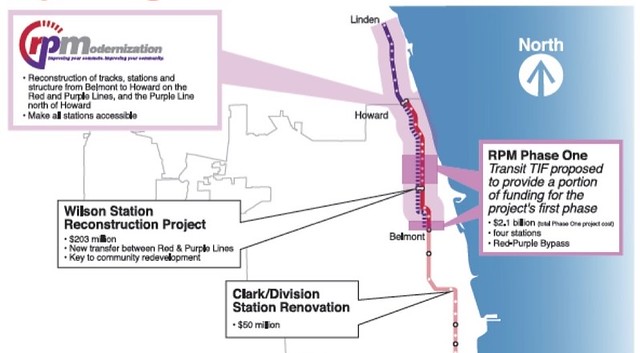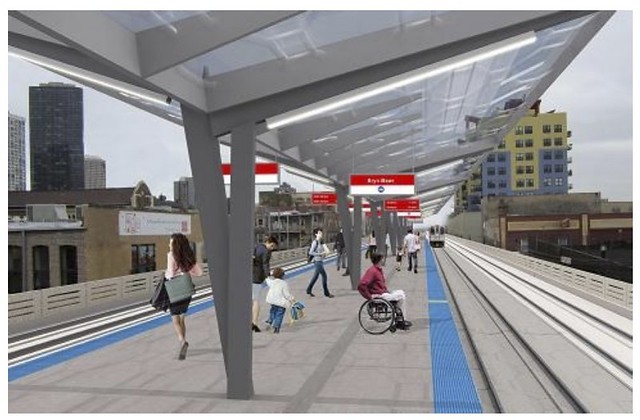
At a public meeting Tuesday night, Department of Planning and Development and Chicago Transit Authority officials outlined plans for a new transit TIF district along the North Side Mainline ‘L’, which carries the Red and Purple lines. The proposed TIF (tax-increment finance district) would generate funds to help pay for the Red-Purple Modernization project.
At the meeting, representatives explained how transit TIFs work compared to traditional ones. The former are a brand-new funding tool that creates a dedicated revenue stream for public transportation projects in Chicago. Earlier this summer the Illinois legislature passed a bill legalizing the funding mechanism, only within the city limits.
The proposed North Side transit TIF would extend from Division Street to Devon Street, within a half-mile east and west of the Main Line, and it would last for 35 years. The TIF district bankroll Phase I of the two-phase modernization project, which includes the Red-Purple Bypass (aka the Belmont Flyover) and the reconstruction of the Lawrence, Argyle, Berwyn, and Bryn Mawr Red Line stations. This will involve rebuilding the tracks and track structures, widening the platforms, and modernizing the station houses, including making them wheelchair accessible. Phase II would include other track improvements and station projects.
The transit TIF would be used to generate revenue to pay back a federal loan for the infrastructure. Since the improved transit service will raise local property values, which means more property tax revenue, the TIF allows some that transit-generated income to be capture and used for the loan payments.
Traditional TIFs, which also capture revenue from property tax increases for improvements within the TIF district, have been widely criticized for diverting tax revenue from the Chicago Public Schools. However, the transit TIF law requires that the proportion of tax revenue currently given to the CPS remains unchanged. After the school funding is allocated, 80 percent of the remaining revenue goes to the transit project and 20 percent to other taxing bodies.
Even after the officials discussed how the North Side transit TIF would function, there was still some confusion from attendees. More than once residents asked if property tax revenue would be diverted from schools, and whether funds from this TIF would be used for projects like the reconstruction of the Wilson Red/Purple Line station or the Clark/Division Red Line stop, which aren’t included in the RPM project.
43rd Ward Alderman Michelle Smith spoke briefly against the proposed transit TIF to loud applause from the audience. She argued that the proposal, which will be going before City Council this fall, was a rushed mechanism to pay for the project. She added ominously that this would be the first-ever TIF district in the ward.
Some residents, especially those who who live south of Belmont in the proposed TIF district, was that while their property taxes would be going into the TIF, they wouldn’t be getting infrastructure improvements near their homes. CTA chief planning officer Carole Morey responded that the improved travel times and rider experience from the RPM project would benefit the entire Red Line corridor from Howard to 95th.
According to the CTA, the Phase I work, including improved signaling, track infrastructure, and the Red-Purple Bypass, which would eliminate traffic jams where the northbound Brown Line currently crosses the Red and Purple tracks just north of Belmont, would allow the agency to run 15 more trains an hour between Belmont and Fullerton on all three lines.
But many central Lakeview residents spoke out against the flyover at the meeting because it will require the acquisition and demolition of 16 neighborhood buildings.
For the most part, however, attendees were generally supportive of the RPM project and the proposed TIF.
Several people did express about what they said was a lack of details about how the transit TIF would function. Others floated constructive ideas to ensure the transit TIF works well, including the addition of a sunset clause in case the funds needed for the project are generated before the TIF expires. An alternative proposal was to use excess funds from the TIF for other Red Line projects south of Belmont, such as making the North/Clybourn station wheelchair accessible.
The biggest proponents of the transit TIF were people who are disabled and representatives of organizations that represent them, who were enthusiastic about the plans for elevators to the Lawrence, Argyle, Berwyn, and Bryn Mawr stops. Several speakers discussed how difficult it can be for Chicagoans with disabilities to get around on transit since many stations are not yet wheelchair accessible.
It was heartening to see the level of support shown for this project, especially when one considers the positive ramifications it will have for the entire Red Line corridor. However, it’s also clear that the CTA and planning department have their work cut out for them in selling the transit TIF to a wary public. But, even though the traditional TIF program has been arguably problematic, the transit TIF represents a significant improvement over the old model.





